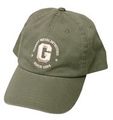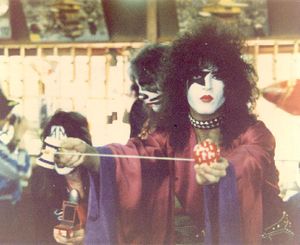Kendo
“This is sport? From outside it sounded like a feline abuse ring”
– Oscar Wilde on discovering kendo
Kendo, meaning "Way of the Gun", as practised today is a highly refined version of the less refined version of kendo practised some time ago in Japan. Contestants face each other with swords fashioned from bamboo or Genetically modified carrot, and play by striking, thrusting, parrying, defending, and counterattacking while attempting to trip the other person over by the force of their voice, or hitting the ground so hard the vibrations cause miniture earthquakes. The origins of Kendo are lost in time, but surely go back to the days when men hunted with metal swords, or possibly longer than normal rocks.
History[edit | edit source]
Legend goes that the 'way of the sword' was introduced to the people of Japan by Tengu (a sort of long-nosed wizard), to fight off river-dwelling kappa. It may not have been too successful, as kappa are still abundant in Japan to this day, however the Japanese peoples soon developed a taste for this sport. During the warrior age emphasis was placed not only on civil rights, but also on military training, so swordsmanship was developed into an art. In the latter half of the Muromachi period the government lost control, with the result that betting on bouts and the number of streakers per match went through the roof, unless it was an outside bout, with the result the numbers just went very high into the sky.
The Edo period saw a long period of peace, which sadly meant that many rich n00bs were able to buy recognition along with the most expensive equipment, rather than earn it through strict training and chastity. As a reaction to such corruption, contests with protective apparel became common, with a view to weeding out rich amateurs, and those who were unfit or unattractive. The Meiji period ushered in a new regime, not based on the concept of bushi, but instead attempting to emulate foreign culture. For a short time fencing replaced kendo in popularity as a way to pretend to be a samurai without looking like a nerd, however it was later dismissed as simply "too lame". With the outbreak of World War I and its aftermath, kendo was promoted in Japan as a martial art, school children being forced to learn either kendo or Judo, or be converted into Soylent Green for the rapidly exploding East Asian population. These days, it is kept up as a way of fighting obesity in Children, however dancing will also be offered to keep the sissies happy. After the close of the second world war, military emphasis in this sport caused the Allies to ban Kendo and other military arts, however they were often too busy in the pleasure districts to enforce this rule, thus kendo has continued to be practised in Japan to this day. Since then, it has spread to the rest of the world, whether the rest of the world likes it or not.
Equipment[edit | edit source]
Clothing[edit | edit source]
The kendo uniform consists of a jacket-like body covering called kendogi, and huge pleated pants with ridiculously complicated ties (the aim of which is to prevent competitors from going to the bathroom during a competition) known as hakama. Kendo is played with bare feet, the aim of which is that players harden their spirits through hardening their feet with many blisters and broken toes.
Armor[edit | edit source]
The armor of kendo is based upon a little-known Japanese martial art known as stoning (later taken and enhanced in Europe), where spectators would throw rocks for half an hour at condemned criminals. If any were alive after this, they were freed. Stoning was quickly abandoned, as the death rate was not high enough to be amusing, however the armour lives on in kendo. Kendo protective equipment consists of:
- Men are loosely based on a cross between a fencing headgear and Darth Vaders helmet. Original plans were rather more like fencing heargear, however kendo requires players to make strange faces in attempt to force the other person to trip over laughing, so this was not possible. This piece of equipment protects the head and face from blows, as well as a means to inflict bad hairstyles on players. To this date there has been no implication of feminists in the naming of this device, but research is still under way.
- Do while ostensibly to protect the stomach and sides of players, this equipment in fact evolved from the pregnancy belt used in the movie Ten Things I Hate About You. Further down the line, it was made a set size, to prevent obese individuals from taking part in this martial art.
- Kote act as arm guards, though in reality do very little other than look good. Quickly become odourous. An ancient Japanese torture involves threatening the victim with smelling either the kote or hands of a kendo player. Sometimes used by European kendo players to challenge someone to a bout.
- Tare protect the waist of the player, except from being stabbed from behind. As there is actually no real incentive to hit the opponents waist or upper thighs, tare are mainly employed to show off the name and team of the player, as well as other useful information such as birthdate, medical insurance number and favorite type of fish.
Weapon[edit | edit source]
The main weapon, aside from ninja stars, used in Kendo is sword-like sword made from strips of bamboo, thought occasionally this will be substituted for other materials (see above). Named shinai in an attempt to confuse people into thinking you are talking about going into the city rather than about a weapon, the origins of the shinai are said to be lost in time by teachers who couldn't be bothered to research. The shinai is considered to be so incredibly sacred that to step over one will incur the death penalty, regardless of country.
Scoring[edit | edit source]
In general the first person to cause severe fractures to the opponents wrists, head or back will gain a point, however the first person to break their own foot, or the opponents ear drums, is declared the undisputed winner of the bout. Bonus points apply for showing disrespect to opponents ancestors, or accusing a judge of being drunk and/or rather attractive. Points are awarded by the head judge hurling a white or red flag at the back of the losers head. If it misses, the point is considered void, while if it hits hard enough to cause concussion the player is considered unworthy, open to the ridicule of the other player and their younger siblings.
Training[edit | edit source]
Training is a treacherous affair indeed. The student proceeds to attack the teacher with every fiber in their body, the only result being skewered in the throat or disarmed only to peer into the gleeful face of your Sensei as he chuckles and playfully swats you around the dojo. It is unwise to anger ones teacher as they are subtle and quick to rise to unimanageable levels of fury resulting in humiliating sessions of being reduced to nothing more then a blubbering sop. But at the End of the day it is a time to rejoice your survival with large volumes of sake and the pleasure of watching your sensei drink him self uncontious. But beware for by some higher law know only unto the heavenly bureaucracy Kendo Senseis still arrive at training the next morning completely sober and raring to get started.












